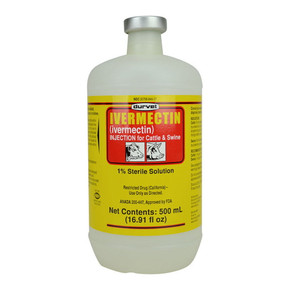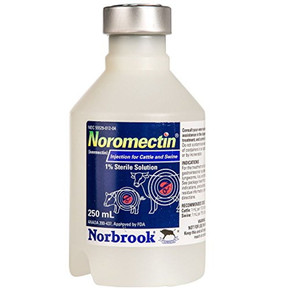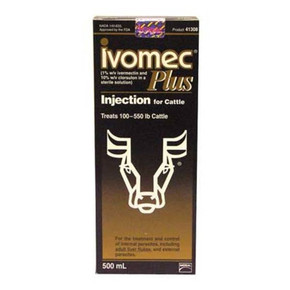
Dectomax 1% Injectable Solution Cattle and Swine Dewormer - 500ml
Not available for sale to California customers
Dectomax Injectable Solution controls more parasite species and larval stages than any other injectable parasite control product.*
Dectomax Injectable Solution is indicated for the treatment and control of gastrointestinal roundworms, lungworms, eyeworms, grubs (see precautions), sucking lice and mange mites. Consult your veterinarian for assistance in the diagnosis, treatment, and control of parasitism.
Features
- Dectomax Injectable Solution has extended activity up to 21 days against Ostertagia ostertagi, one of the most damaging internal parasites. Controlling infection over an extended period delays accumulation of adult worms, subsequently reducing the number of parasite eggs shed onto pasture
- No other single injectable product controls a broader spectrum of internal and external parasites as Dectomax including 36 stages of adult parasites, L4 larvae and inhibited larvae
- Dectomax Injectable Solution is a ready-to-use, colorless to pale yellow, sterile solution containing 1% w/v doramectin (10 mg/mL). In cattle, Dectomax is formulated to deliver the recommended dosage (200 mcg/kg of body weight) when given by subcutaneous (SC) or intramuscular (IM) injection at the rate of 1mL/110 lb of body weight
- As an injectable solution, Dectomax offers precision dosing
- Dectomax is a tissue-friendly injectable solution that can be administered by subcutaneous (SC) or intramuscular (IM) injection in the neck region. The recommended route is via SQ injection to minimize the risk of injection-site blemishes and is in accord with beef quality assurance guidelines
- Improved productivity - In stocker trials, Dectomax Injectable controlled parasites to outgain injectable ivermectin with clorsulon or ivermectin by up to 26 lb
- Preweaned calves treated with Dectomax Injectable before they went to summer pasture gained 28 lb more than untreated calves (p = .05) by the time they were weaned
Approved Uses
- The treatment and control of internal and external parasites of cattle
- For use in beef cattle, including pregnant cows, newborn calves and bulls
- The control of the following harmful species of gastrointestinal roundworms, lungworms, eyeworms, grubs (see precautions), sucking lice and mange mites. Consult your veterinarian for assistance in the diagnosis, treatment, and control of parasitism
- Dectomax Injectable Solution has been proven to effectively control infections and protect cattle from reinfection with Cooperia punctata, Oesophagostomum radiatum and Dictyocaulus viviparus for 28 days, Ostertagia ostertagi for 21 days and Cooperia oncophora and Haemonchus placei for 14 days after treatment
Dosage & Administration
Administer Dectomax Injectable Solution at the recommended dosage of 1mL (10 mg doramectin) per 110 lb body weight by either subcutaneous or intramuscular injection. Beef quality assurance guidelines recommend subcutaneous administration as the preferred route.
Injections should be given using 16 to 18 ga needles, regardless of administration route. Needles 1/2 to 3/4" in length are suggested for SC injections, which should be given under the loose skin in front of or behind the shoulder. A 1-1/2" needle is suggested for IM injections. The only area for IM injections is the muscular region of the neck.
Important Safety Information
Dectomax Injectable has a 35-day pre-slaughter withdrawal period. Do not use in dairy cows 20M of age or older. Do not use in calves to be processed for veal. Dectomax has been developed specifically for cattle and Swine. Use in dogs may result in fatalities.
Dectomax Injectable Controls The Following
- Gastrointestinal roundworms (adults and fourth-stage larvae) - Ostertagia ostertagi (including inhibited larvae), O. lyrata, Haemonchus placei, Trichostrongylus axei, T. colubriformis, T. longispicularis, Cooperia oncophora, C. pectinata, C. punctata, C. surnabada (syn. Mcmasteri), Bunostomum phlebotomum, Strongyloides papillosus, Oesophagostomum radiatum, Trichuris Spp.
- Lungworms (adults and fourth-stage larvae) - Dictyocaulus viviparus
- Eyeworms (adults) - Thelazia Spp.
- Grubs (parasitic stages) - Hypoderma bovis, H. lineatum
- Sucking Lice - Haematopinus eurysternus, Linognathus vituli, Solenopotes capillatus
- Mange mites - Psoroptes bovis, Sarcoptes scabiei
Precautions
- For subcutaneous or intramuscular injection in cattle only
- Dectomax is highly effective against all stages of cattle grubs. However, proper timing of treatment is important. For most effective results, cattle should be treated as soon as possible after the end of the heel fly (warble) season. Destruction of Hypoderma larvae (cattle grubs) when these grubs are in vital areas may cause undesirable host-parasite reactions, including the possibility of fatalities. Killing Hypoderma lineatum when it is in the tissue surrounding the gullet may cause bloat. Killing H. bovis when it is in the vertebral canal may cause staggering or paralysis. These reactions are not specific to treatment with Dectomax, but can occur with any systemic treatment for grubs. Cattle should be treated either before or after these stages of grub development. Consult your veterinarian concerning the proper time for treatment. Cattle treated with Dectomax after the end of heel fly season may be retreated during the winter for internal parasites, mange mites or lice without danger of grub-related reactions. A planned parasite-control program is recommended
Warning
- Do not slaughter for human consumption within 35 days of treatment. A withdrawal period has not been established for this product in pre-ruminating calves. Do not use in calves to be processed for veal
- Not for human use. Keep out of reach of children
Specifications
- Color: Pale Yellow
- Size: 500mL
- Form: Liquid
- Certification: FDA Approved
Not available for sale to California customers
Dectomax Injectable Solution controls more parasite species and larval stages than any other injectable parasite control product.*
Dectomax Injectable Solution is indicated for the treatment and control of gastrointestinal roundworms, lungworms, eyeworms, grubs (see precautions), sucking lice and mange mites. Consult your veterinarian for assistance in the diagnosis, treatment, and control of parasitism.
Features
- Dectomax Injectable Solution has extended activity up to 21 days against Ostertagia ostertagi, one of the most damaging internal parasites. Controlling infection over an extended period delays accumulation of adult worms, subsequently reducing the number of parasite eggs shed onto pasture
- No other single injectable product controls a broader spectrum of internal and external parasites as Dectomax including 36 stages of adult parasites, L4 larvae and inhibited larvae
- Dectomax Injectable Solution is a ready-to-use, colorless to pale yellow, sterile solution containing 1% w/v doramectin (10 mg/mL). In cattle, Dectomax is formulated to deliver the recommended dosage (200 mcg/kg of body weight) when given by subcutaneous (SC) or intramuscular (IM) injection at the rate of 1mL/110 lb of body weight
- As an injectable solution, Dectomax offers precision dosing
- Dectomax is a tissue-friendly injectable solution that can be administered by subcutaneous (SC) or intramuscular (IM) injection in the neck region. The recommended route is via SQ injection to minimize the risk of injection-site blemishes and is in accord with beef quality assurance guidelines
- Improved productivity - In stocker trials, Dectomax Injectable controlled parasites to outgain injectable ivermectin with clorsulon or ivermectin by up to 26 lb
- Preweaned calves treated with Dectomax Injectable before they went to summer pasture gained 28 lb more than untreated calves (p = .05) by the time they were weaned
Approved Uses
- The treatment and control of internal and external parasites of cattle
- For use in beef cattle, including pregnant cows, newborn calves and bulls
- The control of the following harmful species of gastrointestinal roundworms, lungworms, eyeworms, grubs (see precautions), sucking lice and mange mites. Consult your veterinarian for assistance in the diagnosis, treatment, and control of parasitism
- Dectomax Injectable Solution has been proven to effectively control infections and protect cattle from reinfection with Cooperia punctata, Oesophagostomum radiatum and Dictyocaulus viviparus for 28 days, Ostertagia ostertagi for 21 days and Cooperia oncophora and Haemonchus placei for 14 days after treatment
Dosage & Administration
Administer Dectomax Injectable Solution at the recommended dosage of 1mL (10 mg doramectin) per 110 lb body weight by either subcutaneous or intramuscular injection. Beef quality assurance guidelines recommend subcutaneous administration as the preferred route.
Injections should be given using 16 to 18 ga needles, regardless of administration route. Needles 1/2 to 3/4" in length are suggested for SC injections, which should be given under the loose skin in front of or behind the shoulder. A 1-1/2" needle is suggested for IM injections. The only area for IM injections is the muscular region of the neck.
Important Safety Information
Dectomax Injectable has a 35-day pre-slaughter withdrawal period. Do not use in dairy cows 20M of age or older. Do not use in calves to be processed for veal. Dectomax has been developed specifically for cattle and Swine. Use in dogs may result in fatalities.
Dectomax Injectable Controls The Following
- Gastrointestinal roundworms (adults and fourth-stage larvae) - Ostertagia ostertagi (including inhibited larvae), O. lyrata, Haemonchus placei, Trichostrongylus axei, T. colubriformis, T. longispicularis, Cooperia oncophora, C. pectinata, C. punctata, C. surnabada (syn. Mcmasteri), Bunostomum phlebotomum, Strongyloides papillosus, Oesophagostomum radiatum, Trichuris Spp.
- Lungworms (adults and fourth-stage larvae) - Dictyocaulus viviparus
- Eyeworms (adults) - Thelazia Spp.
- Grubs (parasitic stages) - Hypoderma bovis, H. lineatum
- Sucking Lice - Haematopinus eurysternus, Linognathus vituli, Solenopotes capillatus
- Mange mites - Psoroptes bovis, Sarcoptes scabiei
Precautions
- For subcutaneous or intramuscular injection in cattle only
- Dectomax is highly effective against all stages of cattle grubs. However, proper timing of treatment is important. For most effective results, cattle should be treated as soon as possible after the end of the heel fly (warble) season. Destruction of Hypoderma larvae (cattle grubs) when these grubs are in vital areas may cause undesirable host-parasite reactions, including the possibility of fatalities. Killing Hypoderma lineatum when it is in the tissue surrounding the gullet may cause bloat. Killing H. bovis when it is in the vertebral canal may cause staggering or paralysis. These reactions are not specific to treatment with Dectomax, but can occur with any systemic treatment for grubs. Cattle should be treated either before or after these stages of grub development. Consult your veterinarian concerning the proper time for treatment. Cattle treated with Dectomax after the end of heel fly season may be retreated during the winter for internal parasites, mange mites or lice without danger of grub-related reactions. A planned parasite-control program is recommended
Warning
- Do not slaughter for human consumption within 35 days of treatment. A withdrawal period has not been established for this product in pre-ruminating calves. Do not use in calves to be processed for veal
- Not for human use. Keep out of reach of children
Specifications
- Color: Pale Yellow
- Size: 500mL
- Form: Liquid
- Certification: FDA Approved







